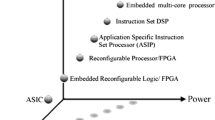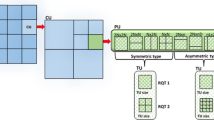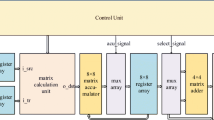Abstract
A new integrated programmable platform architecture is presented, with the support of multiple accelerators and extensible processing cores. An advanced application for this architecture is to facilitate the implementation of H.264 baseline profile video codec. The platform architecture employs the novel concept of virtual socket and optimized memory access to increase the efficiency for video encoding. The proposed architecture is mapped on an integrated FPGA device, Annapolis WildCard-II™ or WildCard-4™, for verification. According to the evaluation under different configurations, the results show that the overall performance of the architecture, with the integrated accelerators, can sufficiently meet the real-time encoding requirement for H.264 BP at basic levels, and achieve about 2–5.5 and 1–3 dB improvement, in terms of PSNR, as compared with MPEG-2 MP and MPEG-4 SP, respectively. The architecture is highly extensible, and thus can be utilized to benefit the development of multi-standard video codec beyond the description in this paper.












Similar content being viewed by others
References
Tekalp, M. (1995). Digital video processing. Signal processing series. Upper Saddle River: Prentice Hall, ISBN:0-13-190075-7. August.
ISO/IEC (2005). Coding of audio-visual objects—Part 10: Advanced video coding, ISO/IEC 14496-10:2005, December 2005.
ISO/IEC (2000). Generic coding of moving pictures and associated audio information: Video, ISO/IEC 13818-2:2000.
ITU (2005). Video coding for low bit rate communication, ITU-T recommendation H.263 (01/2005).
ISO/IEC (2005). Coding of audio-visual objects—Part 2: Visual, amendment 2: Visual extensions, ISO/IEC 14496-2:2004/Amd.2:2005.
Zeidman, B. (2002). Designing with FPGAs and CPLDs. Berkeley: Publishers Group West, ISBN:1-57820-112-8. October.
Choi, J., Togawa, N., Yanagisawa, M., Ohtsuki, T. (2003). System architecture based on hardware/software co-design for optimization of video encoders. A white paper.[Online]. www.ohtsuki.comm.waseda.ac.jp/bunken/pdf/2003/2003choi_jinku_itc-cscc2003.pdf, Sept.
Badawy, W. (2004). Low power video platforms for mobile applications. Tutorial on IEEE International Symposium on Circuits and Systems, May.
Platform-Based Design Solution (2005). CoWare Inc., A white paper. [Online]. www.coware.com/solutions, March.
Dehnhardt, A., Kulaczewski, M. B., Pirsch, P., et al. (2005). A multi-core SoC design for advanced image and video compression. 2005 IEEE International Conference on Acoustics, Speech, and Signal Processing, 5, v/665–v /668, March.
Wiegand, T., Schwarz, H., Joch, A., & Kossentini, F. (2003). Rate-constrained coder control and comparison of video coding standards. IEEE Transactions on Circuits and Systems for Video Technology, 13, 688–703, July.
Ostermann, J., Bormans, J., List, P., et al. (2004). Video coding with H.264/AVC: Tools, performance, and complexity. IEEE Circuits and Systems Magazine, 4, 7–28 First Quarter 2004.
Horowitz, M., Joch, A., Kossentini, F., & Hallapuro, A. (2003). H.264/AVC baseline profile decoder complexity analysis. IEEE Transactions on Circuits and Systems for Video Technology, 13(7), 704–716, July.
Saponara, S., Blanch, C., Denolf, K., Bormans, J. (2003). The JVT advanced video coding standard: Complexity and performance analysis on a tool-by-tool basis. In Packet Video Workshop (PV’03), Nantes, France, April.
Gupta, P. S., & Ramkishor, K. (2004). Novel algorithm to reduce complexity of quarter pixel motion estimation. Visual Communication and Image Processing (VCIP), Proceedings of SPIE, 5308, 31–36 California, January.
Annapolis Micro Systems (2005). WILDCARD™-II and WILDCARD™-4 reference manual, 12968-000 revision 3.2, December.
Xilinx Inc. (2006). Virtex-5 platform FPGA family technical backgrounder. A white paper. [Online]. www.xilinx.com/company/press/kits/v5/v5backgrounder.pdf.
Amer, I., Badawy, W., & Jullien, G. (2004). Hardware prototyping for The H.264 4 × 4 transformation. Proceedings of IEEE International Conference on Acoustics, Speech, and Signal Processing, 5, 77–80, May.
Sayed, M., Amer, I., Badawy, W. (2006). Towards an H.264/AVC full encoder on chip: An efficient real-time VBSME ASIC Chip. In Proceedings of IEEE International Symposium on Circuits and Systems, pp 4, May.
Rahman, C. A., & Badawy, W. (2007). A Verilog Model of CAVLC IP-Block for MPEG-4 Part 10, Contribution to AHG on MPEG-4 Part 9: Reference Hardware, ISO/IEC JTC1/SC29/WG11/ M14102, Marrakech, Morocco, January.
ISO/IEC (1993). ISO/IEC JTC1/SC29/WG11, MPEG-2 video test model 5 (TM-5), MPEG 1993/N0400, April.
ISO/IEC (2001). ISO/IEC JTC1/SC29/WG11, MPEG-4 Video Verification Model Version 18.0 (VM-18), MPEG 2001/N3908, Pisa, Italy.
Acknowledgement
The authors would like to thank the support from Alberta Informatics Circle of Research Excellence (iCore), Xilinx Inc., Natural Science and Engineering Research Council of Canada (NSERC), Canada Foundation for Innovation (CFI), and the Department of Electrical & Computer Engineering at the University of Calgary.
Author information
Authors and Affiliations
Corresponding author
Rights and permissions
About this article
Cite this article
Qiu, Y., Badawy, W. & Turney, R. An Architecture for Programmable Multi-core IP Accelerated Platform with an Advanced Application of H.264 Codec Implementation. J Sign Process Syst Sign Image Video Technol 57, 123–137 (2009). https://doi.org/10.1007/s11265-008-0267-6
Received:
Accepted:
Published:
Issue Date:
DOI: https://doi.org/10.1007/s11265-008-0267-6




